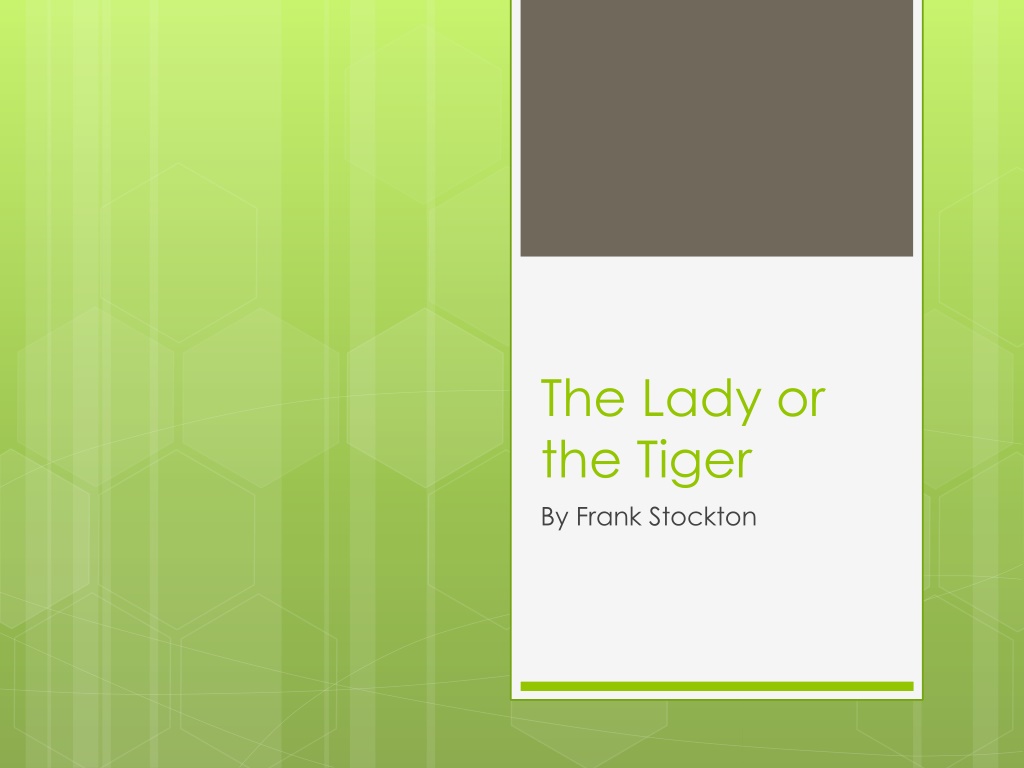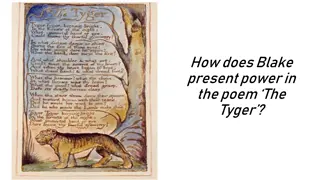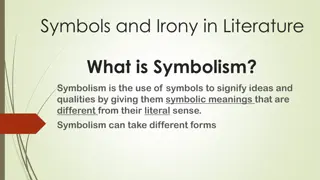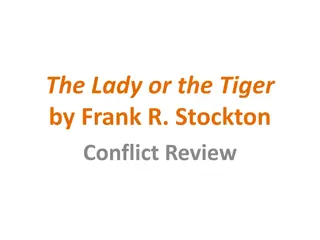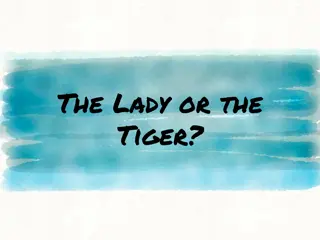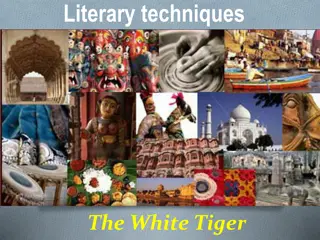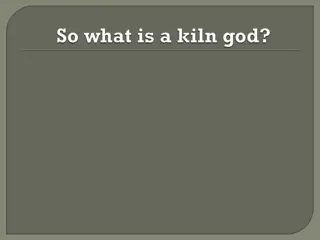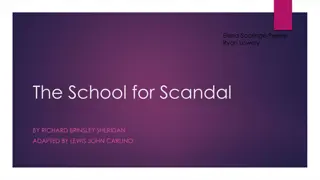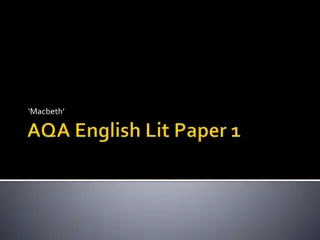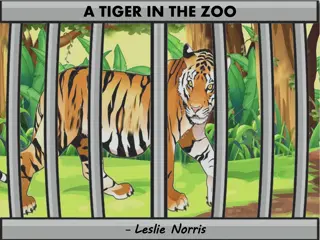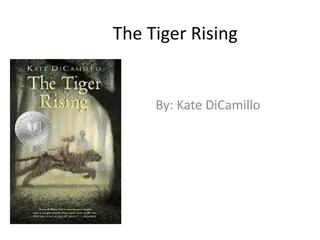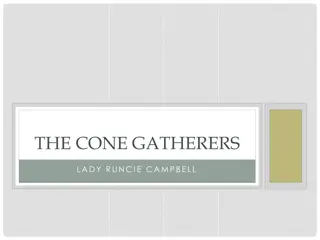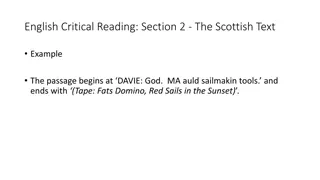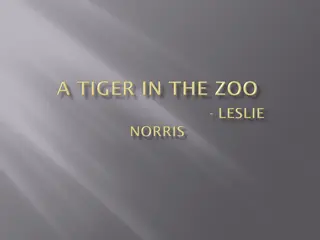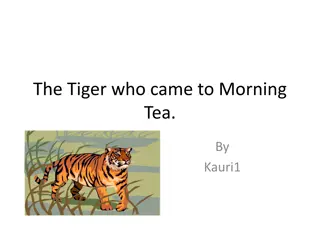The Lady or the Tiger: Analysis and Symbolism
Introduction of characters and plot elements in "The Lady or the Tiger" by Frank Stockton, along with an exploration of symbolism and themes related to choice, love, jealousy, and justice. The story revolves around a princess who must decide the fate of her lover, leading to a dramatic climax that leaves the readers pondering the consequences of her decision.
Download Presentation

Please find below an Image/Link to download the presentation.
The content on the website is provided AS IS for your information and personal use only. It may not be sold, licensed, or shared on other websites without obtaining consent from the author.If you encounter any issues during the download, it is possible that the publisher has removed the file from their server.
You are allowed to download the files provided on this website for personal or commercial use, subject to the condition that they are used lawfully. All files are the property of their respective owners.
The content on the website is provided AS IS for your information and personal use only. It may not be sold, licensed, or shared on other websites without obtaining consent from the author.
E N D
Presentation Transcript
The Lady or the Tiger By Frank Stockton
Plot Mountain Exposition: Introduction of King, the penal system, the princess, and the exposure of her relationship with a man who is beneath her in society. Inciting Incident: The princess discovers which door will hold the tiger and which will hold the fair maiden. Rising Action: The princess struggles with the decision of which door to send her lover toward. The lover looks to the princess for an indication of which door to select. Climax: The princess indicates he should select the door on the right.
The Princess There are many adjectives you could select to describe her. The key is to provide evidence for your choice. Example: Barbaric With all the intensity of the savage blood transmitted to her through long lines of wholly barbaric ancestors, she hated the woman How in her grievous reveries had she gnashed her teeth, and torn her hair, when she saw his start of rapturous delight as he opened the door of the lady!
Symbolism Overall of Tiger & Lady Tiger Guilt Lady Innocence
Symbolism for Princess Choices Choosing the Lady: Love Theme being: Unconditional love is selfless. Choosing the Tiger: Jealousy Theme being: Jealousy causes people to act irrationally.
Setting The setting is relevant because the two doors give the princess a choice thus establishing a conflict. her soul at a white heat beneath the combined fires of despair and jealousy. She had lost him, but who should have him? The arena becomes significant because it drives the plot toward an exciting climax by establishing the mood. Every heart stopped beating, every breath was held, every eye was fixed immovably upon that man.
Irony Signifies the opposite The king felt his system of justice was fair, but having a wife chosen for you is not always a reward. It mattered not that (the accused) might already possess a wife and family , or that his affections might be engaged upon an object of his own selection; the king allowed no such subordinate arrangements to interfere with his great scheme of retribution and reward.
Point of View Third Person Omnisceint He saw, by that power of quick perception which is given to those whose souls are one, that she knew behind which door crouched the tiger, and behind which stood the lady. He had expected her to know it. She had known she would be asked, she had decided what she would answer The king would take an aesthetic pleasure in watching the course of events, which would determine whether or not the young man had done wrong in allowing himself to love the princess.
First Person POV? If told from the princess s point of view, the choice would be known to the reader.
Flashback After the cliff hanger, the author uses flashback to reveal the princess s dreams. These help to develop rising action by building the intensity of the conflict.
Minor Character Impact The Lady behind the door is not just an ordinary lady. She was one who the princess had noticed flirting with her lover. This fair creature throwing glances of admiration upon the person of her lover, and sometimes she though these glances were perceived, and even returned. The idea that her lover would happily fall in love with this chosen woman made the jealousy (the conflict) that much more intense. Had it been a hideous, ill-tempered woman, the princess may not worry that her lover s heart would be stolen from her.
Princess/King They are alike in that they have barbaric characteristics. To even think of sending her lover to the Tiger because of jealousy is barbaric. They are different in that she is struggling with the punishment of the Tiger, but her father does not. For did not the accused person have the whole matter in his own hands?
This Time: Justice is Effective If the fates thought it wrong to love the princess, then the man would be attacked by the Tiger. If the fates thought him innocent of any real wrong-doing, then he would be happily married to a lovely woman to whom he had already expressed affection. Either way, the lover will no longer be with the King s daughter.
Central Conflict Internal: Love versus Jealousy (Emotions) The conflict is resolved because the princess does make a decision. She directs him to the door on the right.
Protagonist The princess is the main character. The conflict, which is internal, is her problem. Being at the center of the main conflict makes her the main character or protagonist.
Antagonist The antagonist could be viewed as the King because he established the conflict for the princess by accusing her lover of treason. However, as it is an internal conflict, we will consider the princess s emotions to be driving her internal conflict.
